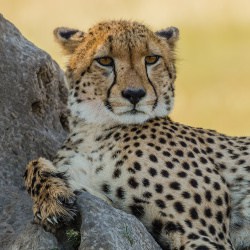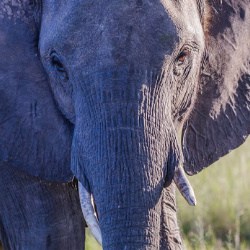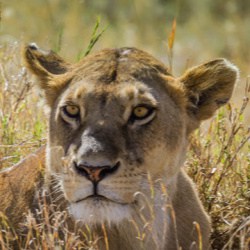The largest nature reserve in Zimbabwe at over 14,000 square kilometers, Hwange National Park has long played host not only to a plethora of wildlife but also to the people interested in seeing it – or hunting it.
This vast stretch of land was originally set aside in the 1800s as the royal hunting grounds for the Ndebele warrior-king Mzilikazi, and later in 1928 it was granted the status of Game Reserve – however, in 1961 Hwange was proclaimed a National Park.
Made up of mopane woodland, grasslands, seasonal wetlands and situated on the edge of the Kalahari Desert, Hwange National Park provides the perfect collection of habitats for its fauna.
It also features the largest variety of bird and mammal species of any Zimbabwean national park. But the area is particularly famous for its elephant population, which is currently estimated to be over 44,000 strong.
With all this and more to look forward to, we’ve put together a handy guide that will help give you some more information and inspiration for your dream trip to Hwange National Park.
Don’t leave home without: Lonely Planet Africa (Travel Guide)
Get A Traditional Safari Experience
Table of Contents
One of the things we absolutely adore about the off the beaten track Hwange National Park is the old school fee it has. Taking a safari in this park is like stepping back in time to the safari experience of old.
There are very few safari trucks, sometimes you don’t even see another when you’re there and the animals are plentiful.
This factor made us fall in love with Hwange, in a way that isn’t possible in a place the Serengeti. While it’s fabulous, it can be crowded at times. Not in Hwange, where you can locate animals at a leisurely pace and enjoy your observations without the pressure from other trucks to move on.
This makes a safari in Hwange special and it’s an experience you shouldn’t miss in Africa.
When to Visit Hwange National Park
The climate at Hwange National Park is mild to warm, with the warmest months being September to March; April to August are the coolest months. As in many tropical countries, Zimbabwe experiences a dry and wet season.
The wet season, from November to March, usually consists of showers in the afternoon that are followed by clear and sunny skies.
July and August constitute the country’s winter, daytime temperatures reach 26°C/79°F and temperatures at night are around 7°C/40°F. The next few months see the mercury rising, with average daytime temperatures of 90°F – in October it’s not uncommon for it to peak over 104°F.
The dry months (July to October) are great for spotting wildlife when birds and animals gather to quench their thirst around watering holes. This is also when there is less vegetation, making wildlife easier to spot.
The wet months (November to April) are alive with green vegetation. There are fewer tourists and accommodation rates may be lower. In addition, baby animals are plentiful, which is always cute to see.
How to Get to the Park
Road
Access to Hwange National Park by road is a good option, and any designated access road is usually possible to use from May through October. However, due to the wet season making roads in the area inaccessible, it’s a good idea to seek advice as to what the best route will be.
In relation to road travel, the visitor reception at each of Hwange’s camps can provide advice on the game-viewing drives that you can go on around the 480 kilometers of the road system located within the park. Camps are connected by road, too, but these roads are not always in the best condition.
Air
Hwange National Park Airport is situated nearby, but services are limited. Currently, charter air travel is available. From here there is a scheduled rotation to Victoria Falls (in operation as of 2011) that runs three times per week.
Air Zimbabwe used to include Hwange National Park on a daily internal flight service that ran from Harare to Victoria Falls, to Hwange, Kariba, and then back to Harare.
There is an airstrip (albeit unlicensed – and with no hangars) in existence at Main Camp and is available for use by private or charter aircraft, but of course, prior permission to land must be obtained at Main Camp.
Priceline and Skyscanner offers great deals to Africa
Things to Do in Hwange National Park
The main activity of Hwange National Park is wild game watching. To see wild animals roaming about in their natural habitats is a rewarding experience and is something that shouldn’t be missed on your trip to this stunning slice of untamed nature.
From hiking and fishing, to simply watching animals drink at waterholes, the activities at Hwange help you get as close to real-life nature as possible.
Thanks to the almost 500 kilometers of road that links the various lodges, camps and nature-watching hotspots of the national park, driving around it can be a pleasant and rewarding experience.
For instance, Ngweshla Pan is a loop road and makes for a great day of travel. In this way you can reach prime game-viewing areas like Nyamandhlovu Platform, featuring a pumped waterhole, and the Dom waterhole, which often has fantastic views at sunset.
Hikes can also be arranged. These are daytime walks into the wilderness of various trails that can be arranged from all camps (for a fee) for groups of up to six people.
Depending on the weather, there is also the opportunity for moonlight game-viewing around the full-moon period. This is available from Main Camp. Other wilderness trails can be embarked upon from Sinamatella and Robins Camp areas.
Our top recommended tours:
- G Adventures The Great Southern Africa Safari
- G Adventures Southern Africa Safari Adventure
- G Adventures Zimbabwe and Botswana Safari
Where to Stay in the Park
Those visiting Hwange National Park have the opportunity to stay in luxury lodges, such as those run by Imelvo, offering a way to see some of the most beautiful sights of nature while staying somewhere clean and comfortable.
For instance, Nehimba Lodge, located in the north, is a private concession where visitors can rest in luxurious, elegant surroundings with African mopane forests on their doorstep.
Then there’s Bomani, located just outside of Hwange on a private reserve with its own entry to the park. Here you’ll find tented luxury. Each of its 11 tents being comfortably furnished with some raised off the ground and some at ground-level overlooking the lodge’s waterhole.
There’s even wi-fi and coffee brought to your bed before morning expeditions.
Read reviews and check prices with our Hotel Search Engine, that gives you the best hotel deals found on the web. Our search engine pulls results from all of the major booking places, including Expedia, Hotels, Booking and more. All the options, all the deals, all in one place and just for you.
Wildlife in Hwange
Hwange is all about wildlife and there is an abundance of it in this park. It is first and foremost renowned for its elephant population. The current population of elephants is around 44,000, based on aerial surveys.
It may surprise you to learn that Hwange’s population of elephants, combined with those across the border in neighboring Botswana, comprise the largest continuous elephant population, a definite flagship for the Kavango Zambezi Trans-Frontier Conservation Area (KAZA TFCA).
Here, visitors can also see fossil sand dunes and the ancient elephant tracks that have run through them for years.
Elsewhere, the diversity of wildlife is clear, with over 100 species of mammals and 400 different species of birds. This includes 19 large herbivores as well as eight large carnivores.
South African lions, leopards, Southern African cheetah, brown and spotted hyenas, gemsbok, as well as wild painted dogs and Cape wild dogs can all be spotted around Hwange National Park.
Hwange is a haven for birdwatchers mainly during the wet season. These new wetland territories attract migratory birds from other African locations.
From the yellow-billed kite, southern ground hornbill, martial eagle, and kori bustard, to the black-winged still, pearl-spotted owlet, and African hobby. Hwange in the wet season is a veritable paradise for birds.
Related Article: African Safari Animals and Where to Find Them
Health & Safety
Malaria is obviously the first thing you should be preparing to prevent against and is at especially high risk during the wet season. Bringing along and applying insect repellent that contains 30% (or more) DEET is a good place to start and anti-malarial drugs would also be a smart move.
It also goes without saying that you should be wearing a hat and applying at least SPF 50 sunscreen (every 90-120 minutes) throughout the day to protect your skin.
Related Article: Ultimate Vaccination Guide for Africa Travel
You will also be seeing wildlife up close and personal and in often quite harsh environments. Following what your guide tells you at all times is recommended. Generally, it’s good not to make much noise, wander off by yourself, leave food in your tent (it will attract animals) or drive too close to animals.
| Recommended Tours | ||
|---|---|---|
 |  |  |
 |  |  |
| Tanzania Safari 7 days Nairobi to Arusha Trip Type: Small Group 12 - 15 People | Masai & Tanzania Safari 10 days Nairobi to Arusha Trip Type: Small Group 12 - 15 People | Serengeti & Ngorongoro Crater Safari 4 days Arusha to Arusha Trip Type: Small Group 12 - 15 People |
| Check Price | Check Price | Check Price |
More on Zimbabwe:
- The Only Zimbabwe Safari You Should Ever Take
- Helicopter Flight Over Victoria Falls
- Adventurous Things to Do in Victoria Falls
- White Water Rafting the Zambezi River in Zimbabwe
- 25 Photos That Will Make You Want To Visit Africa
- Africa Overland Trip Budget – Oasis Overland
- Oasis Overland Trip Through Africa – What to Expect
Other Great Safari Destinations in Africa:
- Chobe National Park Safari Guide
- Etosha National Park Safari Guide
- Serengeti Safari Experience in Africa
- Gorilla Safaris in Africa: Everything You Need to Know
- Epic Sossusvlei Planning Guide








Hi Lina!
The experiences you have shared here are quite fascinating and worthy to read. I’m a local tour guide operator and I think the reader will find it very helpful.
I like the images too.